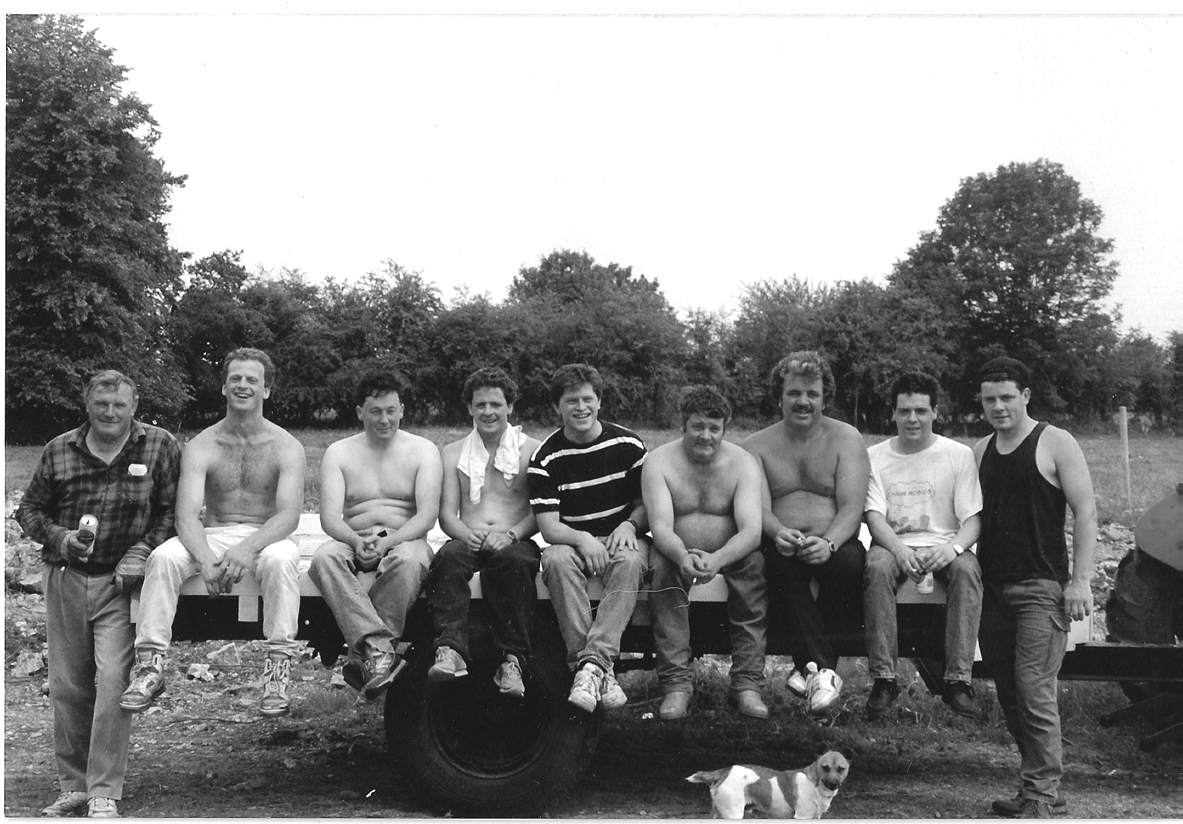by Mary A. Moloney
Ye have been fresh and green,
Ye have been filled with flowers,
And ye the walks have been
Where maids have spent their hours.
“To Meadows” by Robert Herrick (1591-1674)
Many years have passed since my father and I saved the hay together in “Whistlers Field” and “ballyvarra” but the memories come flooding back whenever a lawn or grass is cut nearby. That freshness in the air is all it takes to remind me of days gone by when in March my father would “fence off” Whistler’s (two fields now more commonly known to local readers as Annacotty Business Park) and “Ballyvarra” two fileds located in grance which served as meadows for many generations of Ryan Farmers, Connell’s and Moloney’s.
Each spring, my father would load the horse and cart, later the tractor and “box” with farmyard manure to fertilize the fields, a process known colloquially as “top-dressing”. As I grew older, I helped my Dad with this work and I must admit I enjoyed being out and about in the fresh air, during the Easter holidays or earlier, spreading those loads as evenly as possible around the fields. We were always joined by Tom Mc Namara who willingly gave us a helping hand, because truth be told it was back breaking work. We used pitch forks, four pronged forks braking down each fork full to the smallest possible size in order that it would decompose over the land to improve the quality of the crop. Later fertilizer known as 10.10.20 became the norm. This was ordered from Annacotty creamery and Billy Ber (Birmingham) along with his assistants would deliver the fertilizer to the end of our driveway. From there, my father (who by the mid seventies) had acquired a tractor and spreader would empty the bags of fertilizer into the spreader and happily drive his tractor around the fields thus ensuring an ample supply of fodder for the cows later in the year. By this time, Ferenka – a fore runner to Annacotty Business Park had been built and was working, so the Fir Field became a meadow as did part of the Back Field and later the Road Field.
Time would pass by swiftly and as mid-summer arrived, it was time to cut the hay. In my younger days int eh 1960’s, Martin Hayes, again from Annacotty creamery would cut the hay for the farmers of the parish. Later, as we and many other farmers became self-sufficient, Dad cur the hay with his own tractor and mowing machine. When the hay was cut, then the laborious work of “saving the hay” began. Farmers are always dependent on the weather, so living in a rural community it was a common occurrence that each Sunday, the priest would pray for fine weather. Thankfully, we were often answered in the affirmative and all went well. Plenty of sunshine was necessary to dry the cut grass, it would turn yellow and become crisp, crunchy and brittle to the touch. Saving the hay meant having it so dry of moisture that it could be stored in airless conditions for months on end. Should any moisture remain in the crop when it was finally stored in the hay barn, it would decompose producing heat and steam, the aroma of which would be noted from afar. It rotted the hay and left a covering of dust particles on that which remained. This dust was deadly to both man and beast alike if breathed in. Farmer’s Lung was a familiar term for a lung disease that resulted in serious illness or even death for those who worked with incorrectly saved hay.
But back to saving the hay! When the weather was sunny and fine, it took only a few hours for the hay to dry. Then Tom Mc (as he was affectionately known) my uncles and my father would “turn the hay” so that the underside would dry out too. This was done by the use of a fork or later Dad was able to do it alone with a hay turner. If the weather became wet, which invariably happened, it was necessary to keep a constant look out for a couple of dry hours and th turning might have to be done many times. When the hay was suitably dry, the next procedure was to get it gathered into “cocks” I remember my Dad sitting upion the rake gathering the hay to Tom, my uncles and my mother who working in two’s gathered the hay into a circular shape known as a pike. Tom usually stood in the centre of the circle, placing layers of hay on the ground, also in a circular fashion in order to make the “butt” of the pike. They then continued to place layers on top of each other, all the time lessening the perimeters of the layers so that a narrow rounded top would be formed. This pike of hay was approximately six to seven feet in height. This work continued for the day until the meadow was saved.
When we were saving the hay in Ballyvarra, my mother and I would go up the railway to the meadow (not advisable dear reader) as that was a shortcut from our home. She brought a white tin can of tea with freshly made brown scones, butter and strawberry jam, as well as tarts and fruitcake to feed the hungry who had worked so hard in the meadow al day. I absolutely loved the taste of tea in the meadow, there is something about it, that only experiencing it will allow you to fully appreciate it.
It was them time to “pull the but”. This meant the side of the pikes of hay would be brushed or combed down with a rake, thereby creating an edge all around the bottom for the rain to drain away. A sugán would be twisted and drawn over each pike of hay ensuring their safety from the elements, especially the wind. The pikes of hay remained in on the meadow for approximately two months. Then it was time to “bring home the hay”.
Dad brought home the hay on a horse and float, later a tractor and float. Again fine weather was a necessity. The hay was stored in the hay barn. Again, friends and neighbours were called upon to help for this day’s work. As many as three or four men would be piking the hay into the shed in years gone by, not counting my mother who also helped when the need arose. Though, unfortunately for her she succumbed to the aforementioned Farmer’s Lung thus ending her career in the meadow. Instead, she prepared a good hearty meal for the men and ensured they were well fed with potatoes, bacon and cabbage on the day. Fresh white loaves were purchased from Ryan’s shop in Annacotty that day too along with strawberry jam or home baked tarts for dessert and ham and tomatoes for tea.
Time passes as it always does and piking and saving the hay made way for Timmy Collins and his baler. There was no need for the friends and neighbours then, as Dad and I could put the bales together ourselves. Dad brought them to the barn and we both stored them there together ensuring the cows had a good supply of fodder for the winter. Of course, the cows did not depend totally on hay, they had an ample supply of dairy nuts, pulp, barley and fine meal as well, all delivered from Annacotty Creamery too. But that’s another story!

